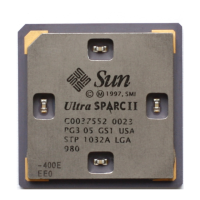Sun Microelectronics
166
UltraSPARC User’s Manual
BUSY: This bit is set when an interrupt vector is received.
MID<4:0>: Module ID of interrupter.
Note: The BUSY bit must be cleared by software writing zero.
The status of an incoming interrupt can be read from ASI_INTR_RECEIVE. The
BUSY bit is cleared by writing a zero to this register.
Non-privileged access to this register causes a
privileged_action
trap.
9.4 Software Interrupt (SOFTINT) Register
In order to schedule interrupt vectors for processing at a later time, each proces-
sor can send itself signals by setting bits in the SOFTINT Register.
SOFTINT: When set, bits<15:1> cause interrupts at levels IRL<15:1> respectively.
TICK_INT: When TICK_CMPR’s INT_DIS field is cleared (that is, the TICK
interrupt is enabled) and the 63-bit TICK_Compare Register’s
TICK_CMPR field matches the TICK Register’s counter field, the
TICK_INT field is set and a software interrupt is generated. See also
Section 14.1.7, “TICK Register,” on page 239 and Section 14.5.1, “Per-
Processor TICK Compare Field of TICK Register,” on page 249.
The SOFTINT register (ASR 16
16
) is used for communication from (TL > 0) Nucle-
us code to (T=0) kernel code. Non privileged accesses to this register will cause a
privileged_opcode
trap. Interrupt packets and other service requests can be sched-
uled in queues or mailboxes in memory by the nucleus, which then sets SOFT-
INT<n> to cause an interrupt at level <n>. Setting SOFTINT<n> is done via a
Table 9-4 Interrupt Receive Register Format
Bits Field Use RW
<63:6> Reserved —R
<5> BUSY Set when an interrupt vector is received RW
<4:0> MID<4:0> MID of interrupter R
Table 9-5 SOFTINT Register Format
Bits Field Use RW
<15:1> SOFTINT<15:1> When set, bits<15:1> cause interrupts at levels IRL<15:1>
respectively.
RW
<0> TICK_INT Timer interrupt RW
Artisan Technology Group - Quality Instrumentation ... Guaranteed | (888) 88-SOURCE | www.artisantg.com

